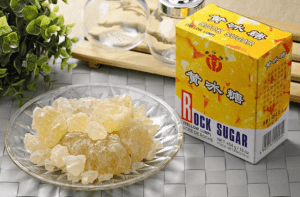Rock Sugar Ginger Chicken
Rock Sugar Ginger Chicken
Chinese cuisine. Chinese recipes. Asian food. Asian recipes.
Ingredients:
- 6.5 bone-in chicken thighs (2.5 lb. total)
- 1 tablespoon salad oil
- 6.5 ounces fresh ginger, scrubbed and thinly sliced
- 1/2 cup fat-skimmed chicken broth
- 2 ounces yellow rock sugar (about 1/3 cup) or 1/4 cup granulated sugar
- 2 tablespoons black soy sauce or 2 tablespoons regular soy sauce plus 1/2 teaspoon molasses
- 1/2 teaspoon salt
- Thinly sliced green onions (optional)
Preparation:
Start washing, rinsing and pat dry chicken. Heat a pan. When hot, add oil and ginger; stir about 4-5 minutes, until ginger is lightly browned. Reduce heat to medium-high; push ginger to edges of pan and add chicken pieces in the center of the pan, skin side down, in a single layer. Cook, turning once, until browned on both sides, about 8 to 10 minutes total. Drain off and discard fat from pan.
Stir broth, 1/2 cup water, sugar, soy sauce, and salt into pan around chicken. Cover and bring to a boil, then reduce heat to medium and simmer 8 minutes. Turn chicken pieces over, cover, and continue cooking until no longer pink at the bone (cut to test), about 10 minutes longer.
With tongs, remove the chicken from the pan juices and place it into a bowl . Skim and discard fat from pan juices; pour juices over chicken. For decoration, you can sprinkle green onions on top of the chicken.
Is this Chinese sugar rocks healthy?
What is a substitute for Chinese rock sugar?
Yellow rock sugar substitute. Substitutions. If you don’t have this ingredient on hand or can’t find it, granulated white or brown sugar will work just fine as a substitute.
Helps In Digestion
Rock sugar is not only used as a mouth freshener but also helps in digestion when had with fennel seeds. It has digestive properties that start the process of digestion immediately. So, to prevent indigestion, consume a few pieces of mishri after a meal.
Will it make me fat?
Your grocer might label scallions as green onions. They’re the same thing. Their pungent relatives include onions, leeks, shallots, and chives. Cooks worldwide toss scallions into soups, salads, stir fries, and any dish that needs a punch of flavor.
Scallion Health Benefits
Fills you with fiber. A cup of cut scallions has about 10% of the fiber you need for the whole day. Getting lots of fiber helps you feel full, keeps your cholesterol levels down, and may lower your chances for diabetes, heart disease, and other conditions.
Helps fight cancer. Scallions and other allium vegetables may block cancer growth, especially in the stomach. Researchers aren’t sure how. They believe that a compound called allicin, which is what gives you garlic breath, may prevent cells from turning cancerous or slow tumors from spreading.
Prevents infections. Extracts of onions, garlic, and their relatives have long been used as medicine. They can kill bacteria, fungi, and viruses. Lab tests on certain varieties of onions showed that at high enough concentrations, some can kill or slow the growth of salmonella or E. coli.
Protects your body. Vegetables in the onion group are packed with phytonutrients, including chemicals called antioxidants that defend your cells against damage. Antioxidants in onions like flavonoids and polyphenols hunt down free radicals, substances that can lead to cancer, inflammation, and age-related diseases. The antioxidants lose their power during cooking, so fresh is best.
Scallion Risks
Scallions are high in vitamin K, which works against blood thinning medication. If you’re taking warfarin to prevent strokes, heart attacks, or blood clots, ask your doctor if green onions are safe for you.
It’s rare, but people have been sickened or died of hepatitis after eating contaminated scallions. Always wash all fresh vegetables, including those that are sold prewashed and bagged.
[otw_is sidebar=otw-sidebar-1]





